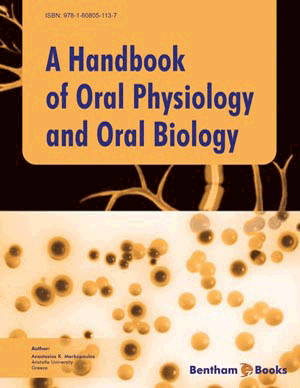Structure and Function of the Cells of Oral Mucosa
Page: 1-6 (6)
Author: Anastasios K. Markopoulos
DOI: 10.2174/978160805113711001010001
PDF Price: $15
Abstract
The mucosa lining the oral cavity varies significantly in its structure and function. In some areas of the mouth, it protects the underlying structures; in others, it provides a means of transepithelial absorption and around the teeth it provides a unique epithelial structure and controls passage of crevicular fluid. This chapter reviews briefly the major structural characteristics of the cells of oral epithelium and connective tissue. The elementary cell mechanisms and functions of keratinocytes and every cell of the connective tissue are also briefly analyzed.
Biology of Bone
Page: 7-27 (21)
Author: Anastasios K. Markopoulos
DOI: 10.2174/978160805113711001010007
PDF Price: $15
Abstract
Bones are rigid organs that form part of the endoskeleton of vertebrates. They function to move, support, and protect the various organs of the body, produce red and white blood cells and store minerals. This chapter briefly covers a wide spectrum of areas related to elementary bone pathophysiological features and basic bone research. While bone embryology, osteogenesis, bone remodeling, bone development, osteoblast and osteoclast biology constitute the main contents, topics important to the understanding of bone metabolic diseases are also reviewed. The significance of bone enhancing factors and effect of immune system on bone is discussed. Elementary knowledge is also given for the relation of bone and implants.
Functions of Oral Mucosa
Page: 28-52 (25)
Author: Anastasios K. Markopoulos
DOI: 10.2174/978160805113711001010028
PDF Price: $15
Abstract
Oral mucosa shows specializations, which allow it to fulfill several roles. It protects mechanically against both compressive and shearing forces. It provides a barrier to micro-organisms, toxins and various antigens. It has a role in immunological defense, both humoral and cell-mediated. Minor glands within the oral mucosa provide lubrication and buffering as well as secretion of some antibodies. The mucosa is richly innervated, providing input for touch, proprioception, pain and taste. All these functions of oral mucosa are the main constituents of this chapter.
Oral Microbial Flora
Page: 53-63 (11)
Author: Anastasios K. Markopoulos
DOI: 10.2174/978160805113711001010053
PDF Price: $15
Abstract
The normal oral flora of humans is exceedingly complex and consists of more than 200 species of bacteria. The composition of the oral flora may be influenced by various factors, including oral hygiene, genetics, age, sex, stress and diet of the individual. At birth, the mucous membranes of the mouth and pharynx are often sterile at birth but may be contaminated by passage through the birth canal 4-12 hours after birth. The development of the teeth is accompanied by the appearance of other regions, which may provide suitable conditions for growth of microorganisms.
Mastication
Page: 64-70 (7)
Author: Anastasios K. Markopoulos
DOI: 10.2174/978160805113711001010064
PDF Price: $15
Abstract
Mastication is the first stage in the process of digestion. In most mammals, controlled vertical and transverse movements of the mandible, as well as protrusion and retrusion of the tongue characterize mastication.
These controlled movements of the mandible contribute also in swallowing and production of speech. In these functions significant is also the contribution of tongue and certain muscles controlling perioral area, pharynx and larynx.
The controlled movements of mastication are not observed from the initial stages of life. However, some non-synchronized movements of mandible start from embryonic life in all mammals. During neonatal life, several masticatory movements are observed, but most mammals are feeded with sucking. Later a gradual shift of kinetic prototypes of sucking to the prototypes of mastication occurs. Mechanisms controlling this shift are multifactorial and are probably related with maturation of neural and anatomic components.
Deglutition
Page: 71-75 (5)
Author: Anastasios K. Markopoulos
DOI: 10.2174/978160805113711001010071
PDF Price: $15
Abstract
Deglutition is a reflex process of muscular contractions aiming to forward food, saliva or other substances from the oral cavity to stomach.
Although deglutition can be caused consciously, in most instances it is caused subconsciously.
Frequency of deglutition is one per minute, which means that during day and night more than 1000 swallowing movements may occur. Decrease of swallowing activity occurs during sleep.
Beyond food and saliva transportation, deglutition may be protective in nature. In collaboration with respiratory movements, breath is stopped during deglutition, so the entrance of food into trachea is avoided.
In case of food entrance into trachea, apart from other protective reflexes, activation of deglutition occurs that contributes to the cleaning of airways.
Mechanisms of deglutition are complex processes requiring the collaboration of extended parts of the brainstem, cranial nerves, sensory receptors and muscles. Masticatory process is programmed through neural circuits in brainstem’s “masticatory center”. If masticatory center is activated for a first time, masticatory process becomes then automatic.
Speech
Page: 76-79 (4)
Author: Anastasios K. Markopoulos
DOI: 10.2174/978160805113711001010076
PDF Price: $15
Abstract
Speech is the most common way of communication between people. As a phenomenon, speech is subdivided into two phases, production and perception of speech. Speech production requires the coordinated action of all anatomic elements of vocal tube. The main theories regarding the activity of speech cerebral theories are two; connection theory and modular theory.
Subject Index
Page: 80-84 (5)
Author: Anastasios K. Markopoulos
DOI: 10.2174/978160805113711001010080
Introduction
This textbook provides a comprehensive overview of the part of dentistry that links basic physiologic and pathophysiologic mechanisms to frequently encountered problems in dental practice. Themes that are covered include the structure and function of the cells of oral mucosa, the biology of bone, the functions of oral mucosa, some important aspects on oral microbial flora and biofilms and finally the current principles on mastication, swallowing and speech. The knowledge of basic sciences is essential in oral biology, helping to understand the nature and behavior of cells, tissues and organs in health and disease. It is an easy-to-read, relatively brief but a comprehensive Ebook appropriate for undergraduate and graduate dental students as well as for practicing clinicians.






















